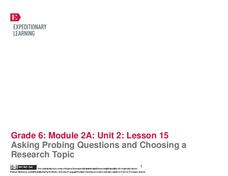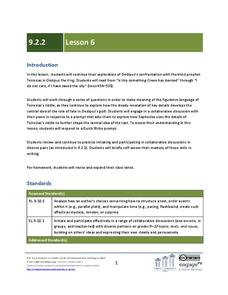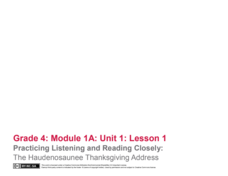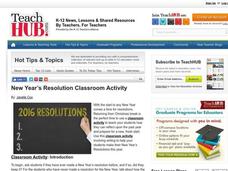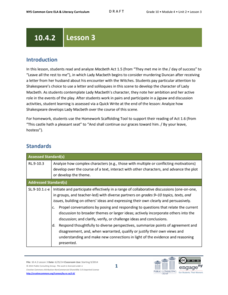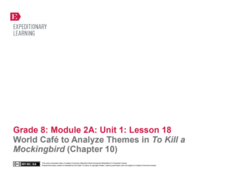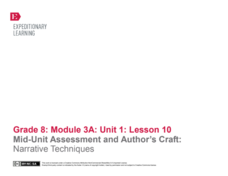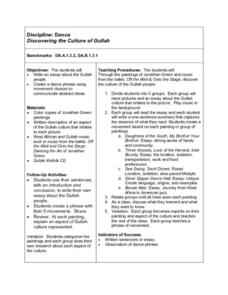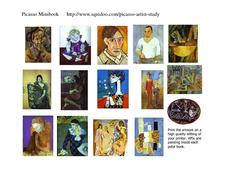EngageNY
Asking Probing Questions and Choosing a Research Topic
Begin the writing journey of an evidence-based essay detailing a rule to live by with various activities to familiarize learners with the topic and jump-start brainstorming. First, pupils take part in an in-depth review and discussion of...
EngageNY
End of Unit 2 Assessment: Final Draft of Literary Argument Essay
Take the last step in writing a literary argument essay using Bud, Not Buddy by Christopher Paul Curtis in an activity focused on feedback. Using the stars and steps revision method, pupils consider teacher and peer feedback to revise...
EngageNY
Qualities of a Strong Literary Argument Essay
One activity, two essays, and one central theme: qualities of an argument essay. Here, scholars first describe the qualities of an argument essay regarding Bud's rules to live by from the novel Bud, Not Buddy by Christopher Paul Curtis....
EngageNY
Pitching Your Claim with Best Evidence
Does Bud use his rules to survive or thrive? That is the driving question of a lesson plan following the reading of Bud, Not Buddy by Christopher Paul Curtis. In an argument essay prewriting activity, pupils use textual evidence to...
EngageNY
Grade 9 ELA Module 2, Unit 2, Lesson 6
The battle of wits and wisdom rages in Sophocles' Oedipus the King, particularly in Oedipus' discussion with Teiresias about the Sphinx's riddle. Ninth graders focus on this crucial conversation with a literary analysis instructional...
EngageNY
Practicing Listening and Reading Closely: The Haudenosaunee Thanksgiving Address
Thanksgiving doesn't occur only once a year for the Haudenosaunee. Weave an instructional activity about reading closely with an inspiring message about eternal gratitude for all of the elements of creation into a unit on Native American...
Teach Hub
New Year’s Resolution Classroom Activity
Create a sense of accountability among scholars with a lesson that focuses on making and keeping New Year's resolutions. Writers compose a five paragraph essay focused on three resolutions—promises to self improvement, to...
Seussville
What Can Your Class Do?
Inspire scholars to do their part for planet Earth with a read-aloud of Dr. Seuss's The Lorax, and variety of activities designed to boost the environmental activist in us all. Activities include writing poems about the Earth,...
EngageNY
Grade 10 ELA Module 2: Unit 1, Lesson 13
Freedom is not free. Scholars write to a prompt analyzing two pieces of work that develop ideas about freedom. Readers compare “Freedom” by Rabindranath Tagore and "Letter from Birmingham Jail" by Martin Luther King Jr. Learners work...
EngageNY
Grade 10 ELA Module 3: Unit 2, Lesson 1
Scholars work through an investigation process to narrow down a question to research. Learners begin by examining the research process, creating a portfolio, and vetting two or three possible topics. For extended work, they search for...
EngageNY
Grade 10 ELA Module 4: Unit 2, Lesson 3
How does Lady Macbeth's ambition help advance the plot of Shakespeare's Macbeth? Scholars explore the topic using discussion and a jigsaw activity. Next, they complete a quick write to analyze how Shakespeare develops Lady Macbeth's...
EngageNY
Grade 11 ELA Module 1: Unit 1, Lesson 3
What do words say about a person? Scholars closely examine the words Robert Browning uses to describe the Duchess in My Last Duchess. They work in groups to answer guided questions about how words help develop the Duchess as a character....
EngageNY
Building Background Knowledge: The Impending Fall of Saigon
Scholars read "Doc-Lap at Last" and participate in a Three Threes in a Row activity in which they answer three questions about the text in their rows. They then discuss the central idea of the text. Readers finish the lesson plan with a...
EngageNY
Jigsaw to Analyze Mood and Tone in To Kill a Mockingbird (Chapter 8)
We have an appointment! Scholars meet with another discussion appointment to discuss the text structure of the poem "Incident" by Countee Cullen. They use a Note Catcher to guide their thinking and compare the structure to chapter 8 of...
EngageNY
World Café to Analyze Themes in To Kill a Mockingbird (Chapter 10)
Time for table discussions. Scholars once again take part in a World Cafe activity. They discuss chapter 10 of To Kill A Mockingbird in groups of four and rotate from table to table. At each table, they select a new leader. Readers then...
EngageNY
Examining How Word Choice Contributes to Tone and Meaning: Close Reading of “Wet and Crying”
Scholars participate in a Write-Pair-Share activity while answering questions about the meaning of words in "Wet and Crying." They use their Write-Pair-Share note-catchers to guide their thoughts and then share with the class. After...
EngageNY
Analyzing Word Choice: Atticus’s Closing Speech (Chapters 20-21)
Choose your words carefully. Scholars begin by reading a line of Atticus's closing speech in To Kill A Mockingbird. Readers work independently on their note catchers, then complete a Think-Pair-Share activity with partners. They finish...
EngageNY
Mid-Unit Assessment and Author’s Craft: Narrative Techniques
Scholars work together to compile a list of things good writers do to perfect their craft and write the ideas on a whiteboard. They then discuss the differences between passive and active sentences and use their knowledge to identify...
EngageNY
Advocating Persuasively in a Fishbowl: Practice
What makes a good advocate? An informative lesson plan teaches class members how to advocate persuasively. They participate in a fishbowl activity and listen to the teacher model advocating persuasively. They then practice independently,...
EngageNY
Assessment Part 3: Advocating Persuasively in a Fishbowl
Class members complete the final part of the The Omnivore’s Dilemma end-of-unit assessment. The portion includes a fishbowl activity where learners demonstrate their persuasive advocacy abilities. As each pupil speaks, their peers assess...
McGraw Hill
Study Guide for Frankenstein
Help the class uncover the story of Frankenstein. Learners answer questions and complete activities to respond to the text Frankenstein as they read. Scholars learn new vocabulary, respond to personal and text-dependent questions,...
Curated OER
Dance: Discovering the Culture of Gullah
It's wonderful to see a lesson that incorporates art, movement, and writing. These three forms of creative expression are explored as learners dance to music from the Gullah people of West Africa. They analyze several paintings, listen...
Curated OER
Picasso Minibook
Display knowledge about Pablo Picasso and his works with a folder book. Learners cut out images, paste them into tiny petal books, and then attach those onto folder pages. In the additional space, pupils write about the words of art.
Seussville
It's Time to Play Seuss-Aphone!
Play a game of telephone, Dr. Seuss style! Kids can use the suggested phrases listed on this page or choose any silly sentence that the famous cat wearing a hat says. See the materials for two more activities.
Other popular searches
- Groundhog Day Art Activity
- Halloween Art Activity
- Puerto Rico Art Activity
- Healthy Eating Art Activity
- Adding Integers Art Activity
- Christmas Art Activity
- Solar System Art Activity
- Earth Day Art Activity
- Pert Rico Art Activity
- Valentine Day Art Activity
- Baroque Art Activity
- Autumn Leaves Art Activity


